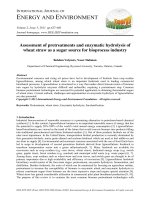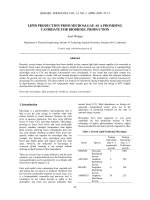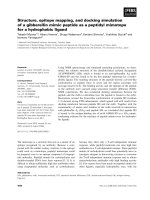Backyard poultry as a resilient technology for augmenting farm income
Bạn đang xem bản rút gọn của tài liệu. Xem và tải ngay bản đầy đủ của tài liệu tại đây (200.35 KB, 6 trang )
�������������������������������������������������������������������������������������������������������������������������������������������������������������������������������������������������������������������������������������������������������������������������������������������������������������������������������������������������������������������������������������������������������������������������������������������������������������������������������������������������������������������������������������������������������������������������������������������������������������������������������������������������������������������������������������������������������������������������������������������������������������������������������������������������������������������������������������������������������������������������������������������������������������������������������������������������������������������������������������������������������������������������������������������������������������������������������������������������������������������������������������������������������������������������������������������������������������������������������������������������������������������������������������������������������������������������������������������������������������������������������������������������������������������������������������������������������������������������������������������������������������������������������������������������������������������������������������������������������������������������������������������������������������������������������������������������������������������������������������������������������������������������������������������������������������������������������������������������������������������������������������������������������������������������������������������������������������������������������������������������������������������������������������������������������������������������������������������������������������������������������������������������������������������������������������������������������������������������������������������������������������������������������������������������������������������������������������������������������������������������������������������������������������������������������������������������������������������������������������������������������������������������������������������������������������������������������������������������������������������������������������������������������������������������������������������������������������������������������������������������������������������������������������������������������������������������������������������������������������������������������������������������������������������������������������������������������������������������������������������������������������������������������������������������������������������������������������������������������������������������������������������������������������������������������������������������������������������������������������������������������������������������������������������������������������������������������������������������������������������������������������������������������������������������������������������������������������������������������������������������������������������������������������������������������������������������������������������������������������������������������������������������������������������������������������������������������������������������������������������������������������������������������������������������������������������������������������������������������������������������������������������������������������������������������������������������������������������������������������������������������������������������������������������������������������������������������������������������������������������������������������������������������������������������������������������������������������������������������������������������������������������������������������������������������������������������������������������������������������������������������������������������������������������������������������������������������������������������������������������������������������������������������������������������������������������������������������������������������������������������������������������������������������������������������������������������������������������������������������������������������������������������������������������������������������������������������������������������������������������������������������������������������������������������������������������������������������������������������������������������������������������������������������������������������������������������������������������������������������������������������������������������������������������������������������������������������������������������������������������������������������������������������������������������������������������������������������������������������������������������������������������������������������������������������������������������������������������������������������������������������������������������������������������������������������������������������������������������������������������������������������������������������������������������������������������������������������������������������������������������������������������������������������������������������������������������������������������������������������������������������������������������������������������������������������������������������������������������������������������������������������������������������������������������������������������������������������������������������������������������������������������������������������������������������������������������������������������������������������������������������������������������������������������������������������������������������������������������������������������������������������������������������������������������������������������������������������������������������������������������������������������������������������������������������������������������������������������������������������������������������������������������������������������������������������������������������������������������������������������������������������������������������������������������������������������������������������������������������������������������������������������������������������������������������������������������������������������������������������������������������������������������������������������������������������������������������������������������������������������������������������������������������������������������������������������������������������������������������������������������������������������������������������������������������������������������������������������������������������������������������������������������������������������������������������������������������������������������������������������������������������������������������������������������������������������������������������������������������������������������������������������������������������������������������������������������������������������������������������������������������������������������������������������������������������������������������������������������������������������������������������������������������������������������������������������������������������������������������������������������������������������������������������������������������������������������������������������������������������������������������������������������������������������������������������������������������������������������������������������������������������������������������������������������������������������������������������������������������������������������������������������������������������������������������������������������������������������������������������������������������������������������������� per bird) was Rs. 51, 320/- per
annum (Table 3).
Farmers) , the no. of eggs produced per
annum, income generated by selling of eggs
per annum, no. of birds sold for meat, total
income generated from eggs and meat of
farmers of 5 villages were also studied (Table
4).
The results on backyard poultry in Nacharam
cluster village belonging to Khammam (D),
Telangana State shown that mortality rate in
birds ranged from 20-30% which happened
due to predators and other factors, the average
number of eggs produced by single bird is
about 160 per annum and the number of eggs
produced per annum in case of 5 villages
ranged from 33,600 to 40,960 and the income
generated by selling of eggs (Rs.4/egg)
ranged from Rs.1,34,400/- to Rs. 1,63,840/per annum. Some birds were sold for meat
purpose and the income generated by selling
of birds for meat in 5 villages ranged from Rs.
5100/- to Rs. 6750/-. “Raja Sri” birds served
as a good income generation source for the
farmers. Farmers in the 5 villages are able to
generate an income ranged from Rs.
1,40,550/- to Rs. 1,68,940/- by combined
selling of eggs and meat produced by the
birds. The average income of the farmer
(Each village 40 Farmers) ranged from Rs.
3513.7/- to Rs. 4223.5/-. Further, farmers with
the remaining number of birds utilizing for
egg and meat production there by getting a
sustainable income generation for their
livelihood and improving their living
standards.
Similarly, for the 5 villages (Each village 40
Table.1 No. of chicks distributed and No. of beneficiaries
Villages
No. of beneficiaries
Nacharam
Colony Nacharam
Gangula Nacharam
Muniya Thanda
Badru Thanda
Total
40
40
40
40
40
200
2254
Unit size
(No. of chicks)
10
10
10
10
10
10
No. of Chicks
distributed
400
400
400
400
400
2000
Int.J.Curr.Microbiol.App.Sci (2019) 8(2): 2252-2257
Table.2 Comparison of the characteristics of the Local desi breed and Raja Sri breed
Particulars
Local variety
Resilient
chicks
(Raja Sri)
500
98
5.5 months
150-160
350- 400
90
6 months
60-80
Weight (2 months) (Gms)
Mortality rate (%)
Egg laying stage
Average number of egg
production/one bird
(per annum)
Income to the farmers by
selling eggs (Rs.)
Egg weight in (Gms)
Kg Weight gain of the
bird
Weight of the bird at Egg
laying stage (Gms)
120-180
(Rs.4/Egg)
45-50
5 months
600-640
(Rs.4/Egg)
52
4 months
1000-1100
1100-1200
Table.3 No. of Eggs produced, meat produced and income generated by “Raja Sri” birds of 10
beneficiaries
S.No
No. of
chicks
distrib
uted
(8 F + 2
M)
Mortality
(%)
Existing no.
of chicks
No. of eggs
produced
per annum
(Avg.160
eggs per
annum)
Income
generated
by selling of
eggs (Rs.4
per egg)
No. of birds
sold for meat
(Rs.150 per
bird)
(avg. 4-6
birds sold
Remaining no. of
birds
Total income
Generated from
eggs and meat
(a)
1
(b)
10
(c)
20
(e)
960
(f)
3840
(g)
750
10
10
1120
4480
900
3
10
10
1280
5120
900
4
10
10
1440
5760
750
5
10
20
1120
4480
750
6
10
30
800
3200
600
7
10
10
1120
4480
750
8
10
20
960
3840
900
9
10
10
1120
4480
900
10
10
30
960
3840
600
(h)
3
(2F +1M)
3
(2F +1M)
3
(2F +1M)
3
(2F +1M)
3
(2F +1M)
4
(2F +2M)
3
(2F +1M)
4
(2F +2M)
4
(2F +2M)
4
(2F +2M)
(f +g)
4590
2
(d)
08
(6F +2M)
09
(7F +2M)
09
(8F +1M)
09
(8F +1M)
08
(7F +1M)
07
(5F +2M)
09
(7F +2M)
08
(6F +2M)
09
(7F +2M)
07
(6F +1M)
Total
100
11,880
43,520/-
7,800/-
2255
5380
6020
6510
5230
3800
5230
4740
5380
4440
51,320/-
Int.J.Curr.Microbiol.App.Sci (2019) 8(2): 2252-2257
Table.4 No. of Eggs produced, meat produced and income generated by “Raja Sri” birds of 5 villages
S.No
1
2
3
4
5
Village
No. of
chicks
distributed
{1 unit 10
birds (8 F +
2 M)}/1
farmer
Mortality
(%)
Existing no. of
chicks
(Male and
female)
Male Female
No. of
eggs
produce
d per
annum
(Avg.160
eggs per
annum
Income
generate
d by
selling of
eggs
(Rs.4 per
egg)
No. of
birds
sold for
meat
(Rs.150
per
bird)
Remaining
no. of birds
(a)
(b)
(c)
(d)
(e)
(f)
(g)
(h)
Nacharam
(40 farmers/
village)
Colony
Nacharam
(40 farmers/
village)
Gangula
Nacharam
(40 farmers/
village)
Muniya
Thanda
(40 farmers/
village)
Badru
Thanda
(40 farmers/
village)
400
20
64
256
40,960
1,63,840/
-
5,100
(34*150)
286
(234F+52M)
400
30
70
210
33,600
1,34,400/
-
6150
(41*150)
239
(191F+48M)
400
25
78
222
35,520
1,42,080/
5550
(37*150)
400
28
58
230
36,800
400
25
66
234
37,440
Total
1,84,320
2256
Total
income
Generated
from eggs
and meat
Avg. Income of
the farmer
(40 farmers/
village)
i
(f + g)
1,68,940/-
4223.5/-
1,40,550/-
3513.7/-
263
(206F+57M)
1,47,630/-
3690.7/-
1,47,200/
6750
(45*150)
243
(203F+40M)
1,53,950/-
3848.7/-
1,49,760/
6300
(42*150)
258
(213F+45M)
1,56,060/-
3901.5/-
7,37,280/
-
29,850/-
7,67,130/-
(i/40)
Int.J.Curr.Microbiol.App.Sci (2019) 8(2): 2252-2257
In conclusion, the backyard poultry
production can be easily boost up with
improved breed of poultry like “Raja Sri”
birds and can promise a better production of
meat and egg to the farmers for income
generation and livelihood. It will serves as an
dual purpose to the farmers both for protein
source from egg and income generation
through selling of eggs and meat. Most of the
families in rural areas who are agriculture
dependent can have the backyard poultry as
an allied sector to the agriculture through
which the living standards and. income levels
improves. Backyard poultry plays an
important role in poverty alleviation,
nutritional security and promotion of gender
equality especially in developing countries
(Gueye, 2000). It ensures meat and egg
availability in remote areas, acts as a
biological pest control agent and caters to the
needs of traditional ceremonies (Alders et al.,
2003).
References
Alders R, Cambaza, A.B and Harun, M.
2003.Village chickens, food security
and HIV/AIDS mitigation. Retrieved
from www.kyeemafoundation.org
Chaturvedani, A.K., Niranjan Lal, Khalid,
Khyalia, N.K and Jitendra Pratap.
2015. Empowering Tribal Women
through Backyard Poultry in Bastar
District of Chhattisgarh. Journal of
Krishi Vigyan. 3:19-22.
Devi, K.S., Rao, S.T.V., Preetham, V.C and
Narasimha, J. 2012. Genetic study on
Immunocompetence traits in certain
synthetic varieties of backyard poultry
birds. In: Proc. of XII ISAGB. 2012.
164-165.
Gueye E F. 2000. The role of family poultry
in poverty alleviation, food security
and the promotion of gender equality
in rural Africa. Outlook on
Agriculture. 29(2): 129-136.
ICAR-Directorate of Poultry Research. 2012.
Vision
2050.
/>mages/extfiles/reports/vision_2050.pd
f
Sapcota, D., Islam, R. and Sheikh, I.U. 2002.
Conserving poultry biodiversity of
India. Livestock International. 6 (12):
20-23.
Singh, R.V., Saxena, V.K. and Sharma, D.
2002. Technological developments in
the poultry sub-sector; In technology
options for sustainable livestock
production in India. Proceedings of
the workshop on Documentation,
Adoption and Impact of Livestock
Technologies in India. 99-103.
How to cite this article:
Hemantha Kumar, J., K. Ravi Kumar, D. Srinivas, Smt P. Sri Ranjitha, P. Raghu Rami Reddy,
Y.G. Prasad and Prasad, J.V. 2019. Backyard Poultry as a Resilient Technology for
Augmenting Farm Income. Int.J.Curr.Microbiol.App.Sci. 8(02): 2252-2257.
doi: />
2257









